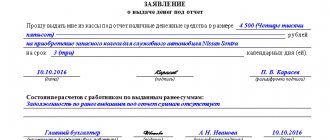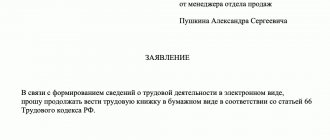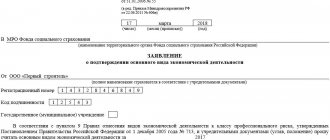General information
Not all entrepreneurs and company owners can count on benefits.
To receive the privilege, quarterly income for the last reporting period must not exceed 2 million rubles. If this is the case, then the taxpayer can fill out an agreement - a form for notification of VAT exemption. The rules vary for business owners working with excise and excisable goods. The benefit can be obtained if separate accounting of product groups is maintained (beer, tobacco products, passenger vehicles are excisable). If products are reflected in documents without this differentiation, VAT exemption will not be obtained.
Who is eligible for release?
Organizations and individual entrepreneurs, if for three previous consecutive calendar months the amount of their revenue from the sale of goods (works, services) excluding VAT did not exceed a total of 2 million rubles. (clause 1 of article 145 of the Tax Code of the Russian Federation).
This right does not apply to organizations and individual entrepreneurs that were engaged in the sale of excisable goods during the three previous consecutive calendar months, as well as organizations that received the status of a participant in a project to carry out research, development and commercialization of their results.
Also, the exemption does not apply to obligations arising from organizations and individual entrepreneurs in connection with the import of goods into the territory of the Russian Federation and other territories under its jurisdiction.
— 3 months have already passed since your registration;
— your revenue (excluding VAT) for the previous 3 months did not exceed 2 million rubles;
— you do not sell excisable goods or keep separate records of transactions for the sale of excisable and non-excisable goods.
— when importing goods into the territory of the Russian Federation;
— when performing the duties of a tax agent for VAT (in the case of leasing state or municipal property, selling goods (work, services) to foreign buyers not registered in the Russian Federation).
The Tax Code of the Russian Federation does not answer the question of what kind of revenue from the sale of goods (work, services) should be taken into account for the purpose of obtaining the right to exemption. If you read the Tax Code of the Russian Federation literally, it turns out that absolutely all revenue should be taken into account. But some departments of the Federal Tax Service allow you not to take into account amounts received from the sale of goods (work, services), the sale of which is not recognized as an object of taxation, as well as within the framework of activities for which you pay UTII.
But income from transactions not subject to VAT on the basis of Art. 149 of the Tax Code of the Russian Federation, according to tax authorities, must be taken into account when calculating revenue. However, some courts do not share this point of view.
It is also not clear whether it is necessary to include turnover from excisable sales in the calculation of revenue.
We received answers to controversial questions from the Russian Ministry of Finance.
From authoritative sources
Vikhlyaeva Elena Nikolaevna, consultant of the indirect taxes department of the Department of Tax and Customs Tariff Policy of the Ministry of Finance of Russia
— from the sale of excisable goods;
- from transactions not subject to VAT on the basis of Art. 149 Tax Code of the Russian Federation;
- from transactions not recognized as an object of VAT taxation on the basis of clause 2 of Art. 146 of the Tax Code of the Russian Federation."
So, it is safer to calculate the total amount of revenue using the method proposed by the Ministry of Finance (that is, also take into account revenue from the sale of excisable goods and from non-taxable transactions).
Release under Art. 149 Tax Code of the Russian Federation
In addition to the benefits provided for in Article 145, the Tax Code identifies transactions that are not subject to VAT. Their full list is contained in Article 149. Non-taxable activities include:
- providing loans;
- transfer of goods, works, services for charitable purposes;
- transfer of promotional items for no more than 100 rubles;
- medical services;
- educational services provided by non-profit organizations (for example, schools);
- Bank operations;
- services in the field of insurance.
The listed operations are exempt from tax regardless of the company's revenue.
How to fill it out correctly
The required document—a VAT exemption notification form—must be submitted to the Federal Tax Service and contain information that confirms the taxpayer’s right to use the benefit.
All that is required is to indicate revenue data and confirm it with extracts from the sales book, balance sheet, and profitability accounting for the last three months. In this case, the taxpayer can count on a positive outcome of the revision of deductions and receiving a tax benefit.
Filling out the form should not cause any problems. You should indicate general information about the company (TIN, name, checkpoint) and write down the amount of revenue for the quarter (it must be deciphered for each month separately).
The notice has completion standards, following which the taxpayer will be able to complete the document without difficulty. There is a scheme, and the VAT exemption notification form, filled out according to the correct algorithm, will be accepted.
For a better understanding of the task, tax officials recommend that an employee who has received instructions to carry out an operation to get rid of VAT first familiarize himself with examples of a completed document and a report without entered information. The taxpayer must understand that the special form of the notification form for VAT exemption is the same for everyone and was developed to exclude non-standard situations. It consists of several parts:
- in the upper right corner, information about the Federal Tax Service is indicated, where the application is being submitted, the name of the company, full name of the payer, TIN and other necessary details;
- main part - here you should enter the requested information about profitability for the last three months and indicate documents confirming this;
- the final point is the signatures of the director and chief accountant.
To be able to take advantage of the privilege, send the required documents and application to the tax authorities no later than the 20th day of the month from which the preferential right is used. Required documents for submission:
- only in the case of an LLC - an extract (certificate) from the balance sheet;
- extract from the sales book;
- only individual entrepreneur - an extract from the recorded book of income/expenses and business transactions.
It is not difficult to prepare all the required documentation and fill out the VAT exemption notification form, especially if you have an accountant on staff. For individual entrepreneurs who manage their own affairs, this task is more difficult to cope with, but a competent example of a VAT exemption notification form, filled out according to all standards, can help.
Taxpayer Responsibilities
Taxpayers are required to submit returns by the 20th day of the month following the reporting year. If an organization wishes to receive an exemption, it must send an application by mail no later than 6 days before the deadline for submitting the application, that is, before the 14th. In addition to this you need:
- pay taxes on time;
- register with the tax authorities;
- submit the declaration within the specified period of time;
- enter information about your activities;
- provide other necessary documents;
- comply with tax requirements when violations of tax legislation are detected;
- for 4 years, retain all supporting documentation regarding the expenses and income of the organization;
- other obligations that are described in the tax bill.
Getting liberated for the first time
— notification of the use of the right to exemption in the approved form;
— an extract from the organization’s balance sheet (Form No. 1) or from the book of income and expenses and business transactions of the entrepreneur. Since revenue is not visible from the balance sheet, the Federal Tax Service often also requests an extract from the profit and loss statement (Form No. 2). To avoid unnecessary communication with tax inspectors, it is better to attach it immediately;
We suggest you read: How people can deceive you when buying an apartment and how to avoid deception
— an extract from the sales book;
— copies of logs of received and issued invoices. The invoices themselves are not needed;
(if) you are switching to the general regime with the simplified tax system or unified agricultural tax, then attach an extract from your income and expenses book to the notification.
Tax legislation does not contain any requirements for the above statements. Therefore, they can be submitted to the tax authority in any form, but the amount of revenue must be visible from them.
Vikhlyaeva E.N., Ministry of Finance of Russia
“Taxpayers claiming exemption from VAT on the basis of Art. 145 of the Tax Code of the Russian Federation, extracts from balance sheets, books of income and expenses, and sales books must be submitted. A simple photocopy of the balance sheet (profit and loss statement), books of income and expenses, and sales book can also be submitted as an extract, if it is certified by the signature and seal of the taxpayer. In my opinion, it is not necessary to specifically imprint the name “Extract” on such a document.”
Example. Preparation of an extract from the sales book
Extract from the sales book
for the fourth quarter of 2009
Seller: Volna LLC
INN/KPP: 7702111222/770201001
Sales for the period: from 10/01/2009 to 12/31/2009
| Period | Total sales, including VAT | Including | |||||
| taxable sales | tax-exempt sales | ||||||
| 18% | 10% | 0% | |||||
| sales price excluding VAT | VAT amount | sales price excluding VAT | VAT amount | ||||
| October | 212 400,00 | 180 000,00 | 32 400,00 | — | — | — | — |
| November | 259 600,00 | 220 000,00 | 39 600,00 | — | — | — | — |
| December | 295 000,00 | 250 000,00 | 45 000,00 | — | — | — | — |
| Total: | 767 000,00 | 650 000,00 | 117 000,00 | — | — | — | — |
Rybakov
General Director ——- A.V. Rybakov
Seal
“Wave” by Afanasyev
Chief accountant ———- E.N. Afanasyeva
(if) they are submitted by express, then no later than the 20th day of the month in which you began to apply the exemption;
(if) sent by mail, then 6 working days before the 21st day of the specified month. It is best to send documents by registered mail with a list of attachments.
For example, if you wish to take advantage of the exemption from January 2010, then the notification must be submitted to the inspectorate no later than January 20. It had to be sent by mail before January 12 (inclusive).
Obtaining an exemption is not tied to any specific period, and you can choose any month. But for tax accounting purposes, it is more convenient to submit a notification in the first month of the quarter—the VAT tax period.
Procedure for filling out a notice for VAT exemption
The notification must be submitted in the approved form. It was introduced into circulation in 2002 by order of the Federal Tax Service. The procedure for filling out the document is as follows:
- The header of the document contains the name of the Federal Tax Service, full name of the individual entrepreneur or name of the company, legal address of the taxpayer, his details (TIN/KPP), contact phone number.
- The main text contains a link to the grounds for receiving benefits (145 Article NK), the name of the individual entrepreneur or legal entity.
- The amount of revenue for three calendar months is indicated: cumulative and monthly.
- The number of sheets in the attached documents is indicated: extracts from KUDiR, sales books, etc.
- The signatures of management, accountant and the date of preparation of the document are affixed.
The notification must be drawn up in two copies. One of them with a note from the tax inspector about receipt of documents and the date of submission must be kept in case of controversial situations (for example, if the notification is lost at the Tax Office).
Filling out the notification itself should not be too difficult for accountants. Sometimes questions arise regarding the rules for submitting supporting information. Thus, according to the recommendations of the inspectors, the company must provide a copy of the invoice log.
In addition to the journal itself, where the details of all services issued in favor of buyers and customers and invoices received from counterparties are entered, it is necessary to submit directly copies of these documents to the inspection.
But some inspections allow the transfer to them of a simple journal extract, which indicates the details and date of receipt of the invoice, the amount of purchase/sale excluding VAT, the amount of VAT and the total amount of expenses and income including VAT.
An extract from the sales book is prepared in the form of a certificate. It specifies the period of statement, the amount of sales including VAT, the amount of the tax itself and the profit received without VAT. The document is signed by the general director and chief accountant.
If during a desk audit inspectors identify inconsistencies, they will charge additional VAT, as well as penalties for late transfer of tax to the budget.
Such discrepancies include failure to provide/falsify supporting documents; missed notification deadlines; identification of grounds that deprive the taxpayer of the right to benefits.
When submitting a request to change tax deductions for the first time, many are interested in where they can find a sample form for notification of VAT exemption. It is freely available. You can view it directly at the Federal Tax Service office or use online resources.
To avoid mistakes when filling out the document, you should study the template - a form for notification of VAT exemption, which is filled out correctly and complies with all standards.
The following restrictions apply to using the VAT exemption:
- Sellers of excisable goods are not entitled to apply the benefit;
- sales revenue excluding VAT should not exceed 2 million rubles for three consecutive months. These indicators do not take into account revenues from transactions that are not subject to VAT.
We invite you to familiarize yourself with: Payments and guarantees to employees under the Labor Code of the Russian Federation in case of staff reduction - Labor assistance
For companies and individual entrepreneurs that use unified agricultural tax, special conditions are provided. After all, they became VAT payers only in 2021:
- those who switched to the Unified Agricultural Tax from 2019 have the right to be exempt from VAT;
- those who previously applied the Unified Agricultural Tax can use the VAT exemption if their income for 2021 is no more than 100 million rubles. In the future, this limit may be lower: for 2021 - 90 million rubles, for 2020 - 80 million rubles, for 2021 - 70 million rubles, for 2022 and beyond - 60 million rubles.
To use the VAT exemption, you must send a notification to the tax office no later than the 20th day of the month from which you plan to apply it. In addition to this, other documents are required:
- an extract from the balance sheet - for companies or from the book of income and expenses - for individual entrepreneurs;
- extract from the sales book.
The notification will also need to be submitted one year after the application of such an exemption. This must be done if you decide to continue using this procedure or if you abandon it. Attach documents with data on the amount of revenue entitling you to the benefit. It is not possible to refuse release earlier than after 12 months. An exception is failure to comply with the conditions for applying benefits on the amount of revenue and others.
For Unified Agricultural Tax payers, no additional documents are needed, just submit a notification. It is also not required to confirm the right to exemption every year. But you won’t be able to refuse the benefit after a year. You can switch to paying VAT only if you lose your right to exemption. In this case, it will no longer be possible to apply the exemption in the future.
VAT in the “transition period”
Before applying the exemption, you need to restore the VAT previously accepted for deduction on all of your remaining inventory, fixed assets and intangible assets that were purchased for operations subject to VAT. This must be done in the last quarter, that is, when you are still a VAT taxpayer.
If you have under-depreciated fixed assets, then VAT must be restored on their entire residual value.
Attention! Before switching to VAT exemption, you need to restore VAT on the cost of inventories, fixed assets and intangible assets.
(or) to terminate the contract and return the advance payment in full;
(or) to amend the terms of the contract price and return only the amount of advance VAT to them.
If you cannot reach an agreement with the buyer, you will have to issue an invoice including VAT upon shipment. But there is no need to pay tax to the budget a second time (you have already paid it in advance). If the advance was partial, then upon shipment you need to pay VAT on the unpaid part.
Who has the right to use the VAT exemption notice?
So, if the notification with all the necessary documents is submitted to the tax office on time, then from the 1st day of the month in which you submitted it, the exemption must already be applied. There is no need to wait for any special permission from the tax authorities, because the exemption is of a notification and not a permitting nature.
Warn the manager
Before obtaining VAT exemption, all existing contracts in which your company acts as a seller must be amended in part of the price, indicating it without VAT.
— calculate and pay VAT;
— issue advance invoices;
— submit tax returns to the Federal Tax Service.
— issue shipping invoices to customers. After all, this is what the Tax Code of the Russian Federation prescribes. At the same time, VAT is not allocated in them and the note “Without tax (VAT)” is made. Otherwise, the Federal Tax Service may fine you 5,000 rubles, and if you have not issued invoices for several quarters, then 15,000 rubles;
— maintain books of purchases and sales, as well as journals of received and issued invoices. You will need these documents subsequently to confirm compliance with the revenue limit for the period of application of the exemption, as well as to extend it;
— despite the VAT exemption, an invoice was issued with the allocated tax amount. The submitted VAT must be paid to the budget. At the same time, the right to exemption from VAT is not lost;
— became a tax agent for VAT;
— paid VAT on the import of goods (work, services) from Belarus.
From the moment the exemption begins to apply, you will have to take into account the input VAT in the cost of goods (work, services, fixed assets).
Attention! Despite the exemption, shipping invoices must be issued.
Business purpose and business division
Another condition that must be met to account for expenses and apply deductions: the purpose of the transaction should not be only a tax benefit.
They suggest checking this using an “express test”. It will be carried out on each individual transaction in the totality of transactions that together led to the achievement of a business goal. Here the tax authorities will need to answer the question whether the taxpayer would have performed this transaction if there were no other transactions, and whether its main purpose was tax benefit. At the same time, the unprofitability of the transaction for the taxpayer in itself cannot be equated with the absence of a business purpose.
If the result of the “express test” is negative, then the tax office will need to additionally prove that the final business goal could have been achieved without the controversial transaction.
All these provisions apply to business splits, which can be called a special case of operations without a business purpose with elements of “technical” companies. Additional criteria that allow the Federal Tax Service to determine that we are talking about fragmentation:
- the same employees and resources;
- close interaction of all participants in the scheme;
- different but inextricably linked areas of activity that constitute a single production process to achieve a common result.
When assessing additional taxes in connection with fragmentation, tax authorities are recommended to identify the actual tax obligations of the taxpayer. This means that not only the income imputed to him will be taken into account, but also the corresponding expenses, VAT deductions, as well as the amount of taxes already paid.
We confirm the release
At the end of 12 months of application of the exemption, no later than the 20th day of the next month, you must submit to the Federal Tax Service documents confirming that your revenue during this time every 3 consecutive calendar months did not exceed 2 million rubles. The list of such documents is the same as when notifying the inspectorate of the beginning of the application of the exemption.
If the revenue exceeds the specified limit, then you will lose your benefit starting from the month in which the excess occurred. This means that from this month you become a VAT payer (see below for more details).
Example. Determination of revenue for every 3 calendar months
Condition
The organization began to apply VAT exemption from the beginning of the year. In January, revenue amounted to 350 thousand rubles, in February - 730 thousand rubles, in March - 800 thousand rubles, in April - 500 thousand rubles.
We invite you to familiarize yourself with: Criminal law as public law, Criminal law as substantive law, Criminal law and other divisions of branches of law
Solution
We sum up the revenue for every 3 consecutive calendar months.
Step 1. Check the amount of revenue for the first 3 months: 350,000 rubles. 730,000 rub. 800,000 rub. = 1,880,000 rub.
The amount of revenue is less than 2 million rubles, which means that in March the right to exemption is not lost.
730,000 rub. 800,000 rub. 500,000 rub. = 2,030,000 rub.
The amount of revenue exceeds 2 million rubles, therefore, from April 1, the organization loses the right to exemption and must charge VAT on goods sold in April and pay it to the budget.
(or) continue to apply the exemption for the next 12 months. In this case, together with the above supporting documents, you must send a notification to the Federal Tax Service regarding the extension of the use of this right. The form of notification is arbitrary, but you can use the same form as when you first received the exemption;
(or) return to the general rules for paying VAT. Then the inspectorate must submit a notice of refusal to use the right to exemption, also in any form.
In the Federal Tax Service of Russia No. 24 in Moscow
from the Limited Company
responsibility "Volna"
TIN 7702111222, checkpoint 770201001,
OGRN 1037739000111
Address: 115552, Moscow,
Kashirskoe highway, 15
https://www.youtube.com/watch?v=ytpolicyandsafetyru
Tel. 345-67-89
Notification
on refusal to release from duties
VAT taxpayer
In accordance with paragraph 4 of Art. 145 of the Tax Code of the Russian Federation, we inform you that Volna Limited Liability Company refuses to exercise the right to be exempt from fulfilling taxpayer obligations related to the calculation and payment of value added tax from January 1, 2010.
Documents confirming that during the exemption period (from January 1, 2009 to December 31, 2009) the amount of revenue of Volna Limited Liability Company from the sale of goods (work, services), calculated in accordance with clause 1 of Art. 145 of the Tax Code of the Russian Federation, excluding tax for every three consecutive calendar months in the aggregate did not exceed two million rubles, are attached.
Seal of the Fishermen
General Director of LLC ——- A.V. Rybakov “11” January 2010
"Wave"
Note
When switching from the general regime (using VAT exemption) to the simplified tax system or another special regime, also submit to the Federal Tax Service a notice of refusal to use the right to exemption with documents confirming the compliance of your revenue with the norm. Although the courts believe that this need not be done, it is better to protect yourself from unnecessary claims from tax authorities.
You should not be late in submitting the notification and supporting documents, otherwise the Federal Tax Service will definitely take advantage of the opportunity and charge you additional VAT for the entire period of application of the benefit. You will have to prove your case in court, which will most likely support you.
Reasons
An individual entrepreneur and an enterprise that produces these products can be exempt from paying tax.
At the same time, exemption from payment is not an obligation, but a right, and almost all organizations can take advantage of it. Thanks to this, companies will be able to avoid paying taxes. The main and only condition for this is the absence of VAT in invoices.
Companies have the right to pay taxes throughout the year. The exemption takes effect upon submission of documents. Once the right is exercised, the company may choose not to file tax returns or pay taxes to the government. As soon as the right has arisen, do not forget that the invoices are marked “Without VAT”. During the entire exemption period, the company must confirm its rights.
To be exempt from payment:
- 3 months before the expected date of filing the application, the enterprise’s revenue from the sale of goods should not exceed 2,000,000 rubles;
- it is necessary to keep records of the sale of goods, including excisable and non-excise ones.
If a company sells excisable and non-excise goods, then it has the right to exercise the right to exemption. However, non-excise ones are not automatically subject to such tax.
It often happens that an institution complies with all of the above conditions, but cannot be exempt from tax. Organizations that have been trading only excisable goods for three months have the right to be exempt from payment. These include:
- alcohol;
- beer;
- tobacco and tobacco products;
- petrol
- cars.
All goods are specified in Article 181 of the Tax Code of the Russian Federation.
What to pay attention to
When taken to its logical conclusion, the act—the VAT exemption notification form, approved by the tax authorities—carries businesses not only benefits, but also obligations. This should be taken into account when submitting a request to the service.
Benefits of getting rid of VAT:
- minimizing the price of services and goods;
- fixation of cost;
- exclusion of separate type accounting at minimum speed.
Disadvantages resulting from preferential taxation:
- fine in case of violation of conditions;
- restoration of residual tax;
- the amount of recovery is not taken into account;
- there is no opportunity to sign contracts with organizations that charge value added tax.
The amount of the fine for late filing of a declaration is 1,000 rubles, so you should prematurely think about filling out an act - a notification form for VAT exemption - and submitting it to the tax service. The exemption from contributions is valid for 12 months, after which it can be extended or this benefit can be waived.
Deadlines
The exemption is valid for a year.
The period starts counting from the month of filing the application. If the rules are violated, for example when revenue is exceeded, the payer pays the full tax. Payment is made after filing the declaration and violating the conditions. The tax is paid to the state budget, taking into account the amount of penalties. It is calculated independently. For correctness, you can use the calculator posted on the website of the Federal Tax Service nalog.ru.
Payment must be made prior to filing the return or a late payment penalty may be assessed.









